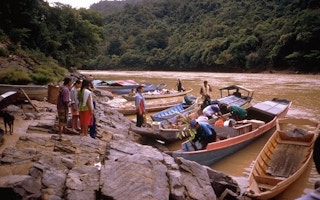From forest fires raging across five continents to glaciers melting faster than ever before, the world looks increasingly apocalyptic. The good news is there is a simple solution, and I witness it daily in my conservation work: invest in indigenous peoples and local communities (IPLCs) living in and around our wild places to conserve 30 per cent of our planet’s land and water by 2030.
To continue reading, subscribe to Eco‑Business.
There's something for everyone. We offer a range of subscription plans.
- Access our stories and receive our Insights Weekly newsletter with the free EB Member plan.
- Unlock unlimited access to our content and archive with EB Circle.
- Publish your content with EB Premium.
Protecting one-third of the Earth is the magic fraction global scientists have identified will avert what looks increasingly like the end of the world. By setting aside the planet’s last wild places for biodiversity, they can sustain the other two-thirds we as a global community require for drinking water, a stable climate, and our agricultural needs.
An action plan for protecting the Earth, known formally as the post-2020 Global Biodiversity Framework, is currently under negotiation at the United Nations Convention on Biological Diversity (CBD). Involving 190 countries and covering myriad conservation issues, disappointingly the most critical aspect of sustainably protecting biodiversity remains sidelined: Duly recognising the enduring contribution, and unparalleled experience, of IPLCs living in and around our wild places to safeguard the planet. And doing so at a significantly lower cost.
Research shows that indigenous peoples spend a fraction—between 16 and 23 per cent— of the budget of global conservation institutions on land protection while delivering the same outcomes. Deforestation on their watch is also half compared to lands managed by others. And though only representing 6 per cent of global population, they protect a whopping 85 per cent of global biodiversity.
Working on the ground with IPLCs on Palawan island, I witness their powerful efforts to prevent deforestation first-hand. Together with my organisation, the Centre for Sustainability PH, the IPLCs living in and around Cleopatra’s Needle have successfully protected this disappearing stretch of pristine rainforest as a Critical Habitat.
And while government and enforcement authorities have had almost no presence at Cleopatra’s Needle due to Covid-19, on meagre resources these IPLCs continue to defend their homeland, the Philippines’ biggest critical habitat, from destruction throughout lockdown.
Increasingly, the scientific community recognises the pivotal role of IPLCs and traditional knowledge in overcoming our biodiversity and climate crises. It is high time to apply this to global policy.
To invest in IPLCs, international agreements must legally recognise and defend their land rights from relentless incursion, particularly mining and agribusiness. Indigenous lands represent 37 per cent of global natural lands and store 25 per cent of the world’s remaining aboveground carbon. On one-third of these lands, IPLCs do not have secure tenure.
The CBD must change this by prioritising the establishment of areas conserved by indigenous and local communities, elevating IPLCs as the primary decision-makers and managers of protected areas.
Finally, investment must prioritise simple cash transfers for IPLCs to spearhead on-the-ground conservation. Without the burdening overheads of global conservation institutions, investing in IPLCs is not just about sustainability. Frankly, it’s just sound economic policy.
KM Reyes is a community organiser and conservationist based on Palawan island in the Philippines. She was born and raised in Australia to Filipino parents, and has lived and worked extensively in Europe, Latin America, and North Africa before deciding to return to her roots and settle in the Philippines.











